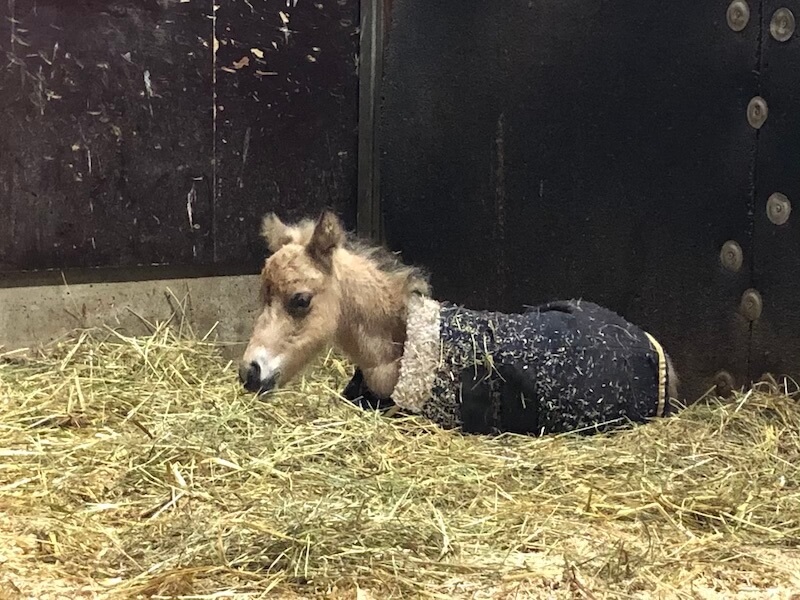Breeding miniature horses is not for the faint-hearted and there are a lot of things to consider beforehand. That is why I have compiled a small checklist with the most important points to consider.
- Real assessment of breeding horses
Almost every horse owner looks at his own horse through rose-tinted glasses and thinks it is the best, most beautiful and cleverest of all. However, as soon as you are confronted with a second opinion in the form of a show or breeding judge, it is not uncommon for disillusionment to set in. When evaluating your own mare or stallion, you should try to assess the strengths and weaknesses of the horse realistically. The “Standard of Perfection” and the breeding objective with the breed characteristics are good points of reference for the assessment. A correct conformation (including teeth), general health and a solid character should be present in any case. You should critically ask yourself whether your Mini absolutely has to reproduce or if might not be better to not produce more horses with the same flaws or issues, physical or otherwise.
- Genetically tested?
Genetic testing is routine nowadays and it is hard to imagine life without it. On the one hand, DNA testing for parentage testing is now standard for AMHA registration. Without DNA testing of the parents (parent qualified), the resulting foals will not get their AMHA registration. With AMHR and ASPC, no DNA test is required, but it can be done optionally and the result can be registered.
Also very important is the ACAN test. ACAN dwarfism is a genetic disease in miniature horses and ponys. It is tested whether the horse carries one or more of the gene mutations that cause this pathological dwarfism. The disease only occurs if both copies of the gene are affected by the mutation. Horses that have only one copy of the mutation are called clinically healthy carriers. When crossed with ACAN-free horses, there is no risk of disease in the resulting foals, although they may carry one copy of the gene. The ACAN test is not very expensive, quickly done and nowadays a must for miniature horses.
- Paperwork is a must
Prospective breeding horses should be in possession of the permanent AMHA paper. After birth, a temporary AMHA paper is issued for the time being. This expires after the horse’s third birthday and becomes invalid. As the owner, you have to apply for the permanent paper, stating the size of the horse. With AMHR it is a little different, here the temporary paper is valid until the horse’s sixth birthday. Unlike with AMHA, the permanent paper is not a requirement for the registration of offspring with AMHR.
- Artificial insemination
Artificial insemination is uncommon in the Miniature Horse industry. Almost no stallion owner offers fresh, chilled or frozen semen. Most breeders use their own stallions. Others bring their mares to the stallion owner. The mares stay there until they are in foal and the pregnancy has been confirmed by ultrasound. If you have several mares, it may be worthwhile to lease a stallion for a season or at least 2-3 months. Leasing a stallion is not that uncommon for miniature horses and saves you the transport for several mares. However, it requires that you have the infrastructure to keep the stallion at your own stable. Most of the time, miniature stallions are easygoing and nice to have around, but I have also come across the odd exception ;-).
- Monitoring the birth
Pretty much all Miniature Horse breeders agree on this: under no circumstances should you let your Miniature mare foal without supervision. All too often things goes wrong and you have to intervene, even if it is only to open the amniotic sac. Every year I hear and read of cases where mares have foaled unexpectedly early and without much signs, the amniotic sac did not open and the otherwise healthy foal suffocated. There are various birth monitors and alarm systems for horses on the market, many of which are also suitable for miniature horses. Combined with surveillance cameras, there is a high degree of certainty that you will not miss the birth.
- Birth problems in Miniature horses
Also something every breeder will tell you: Miniature horse breeding is not for the faint of heart and birth problems are unfortunately not uncommon. The smaller the horse, the greater the risks in pregnancy and birth. Foals born in the wrong position, foals born very early (300 days or sometimes even less) or a prematurely detached placenta (red bag birth) are not as rare as one might think. You should inform yourself as well as possible in advance through videos and reading up, so that in an emergency you can assess the situation correctly and intervene or get help.
If all this didn’t scare you off, you can start looking for a suitable stallion for your mare :-). Getting touch with other breeders can be helpful, the mini-scene is well connected and everyone knows everyone. There are also stallion owners with several horses who lease out their stallions.
If you are afraid of the effort and the risks, but still dream of cute little foals frolicking in your pasture, you can send your mare to a professional facility for foaling out. There are large stud farms that offer this service and can guarantee 24/7 monitoring. They take care of the birth and the first weeks of life, help with all the formalities and then your mare and foal will return back home. Another option is to buy one or two foals instead of breeding yourself. In this case, you are not there from the first minute of life, but you may save many tears and a lot of money.

